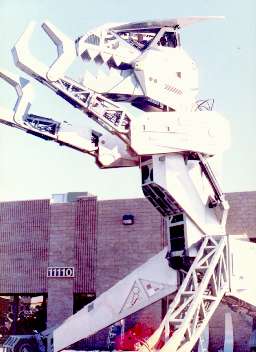Using shoulders, arms, fingers and feet, the pilot can control 18 hydraulic functions simultaneously.
PILOT'S CONTROL ARRANGEMENT
Using shoulders, arms, fingers and feet, the pilot can
control 18 hydraulic functions simultaneously.

FIGURE 9a. Cockpit Internal Details
Dale Thompson, Parker Fluid Power Consultant sits in the cockpit. The arm rest control unit slides back and forth (shoulder control) and simultaneously can be pivoted up and down (elbow control) while also working all finger controls. The pilot's main outward visibility is through the robot's triangular eyes (covered with one way tempered glass). Also note overhead switches and instruments.

FIGURE 9b. Additional Pilot Visibility
Chip Knothe, Applications Manager of Parker's HPI Control Valve division looks out the roof of Robo's head. When finished, dark tinted translucent plastic sheets will cover this area to provide necessary forward visibility when operating with the monster's head tilted down.

FIGURE 9c. Pilot and Copilot - Four Stories Up
Frank Yaeple, Design News, Fluid Power Editor takes the Monster Robot basic training course. Note: Bob Correll in jump seat behind Frank. Originally designed as a passenger seat for members of the media, it became clear in early tests that a solo pilot had far too many tasks. Thus, the addition of a co-pilot. (Note: a couple of years later we gained the passenger/press seat back by changing all these functions so they could be operated via remote control radio from outside the robot. Basically, Robosaurus pilot, Mike Ryder, really had a difficult time judging just where Robo’s claws were in relation to the car being picked up. In a couple of instances, Mike inadvertently dug 1 foot deep grooves into the asphalt stadium floors when trying to scoop up a junk car! Mike’s brilliant, simple solution was to have an outside crew member videoing the action from the side with a system that broadcast this side view of the claws up to a color monitor set up in front of Mike right there up in the head!)
Page 9